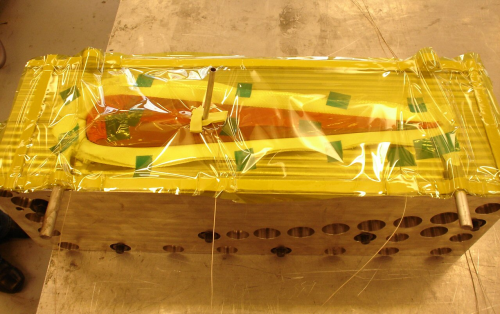
According to Delft University of Technology (TU Delft) PhD researcher Julie Teuwen, the melt impregnation methods normally associated with thermoplastics are inappropriate for producing large wind turbine blades because of the fibre penetration difficulties and the associated need for high processing temperatures and pressures. Producers would prefer to be able to use existing techniques, in particular the vacuum infusion method widely used for large blade manufacture with thermosets today. Vacuum infusion is favoured for its moderate investment cost and its ability to produce a continuous series of large components – albeit blades have to be produced in two halves.
But vacuum infusion of fibre-dense preforms requires a resin runny enough to be able to penetrate the fibres fully. Unfortunately, the high-performance thermoplastic matrices first developed for aerospace – polyether-etherketone (PEEK), polyether-ketoneketone (PEKK), polyetherimide (PEI), polyethersulphone (PES) etc, along with the lower service temperature polybutylene teraphthalate (PBT), polyamide (PA) and polypropylene (PP) etc – are normally too viscous, their melt viscosities being many times higher than those of thermosets. However, some less viscous thermoplastics are available and it has been shown that certain thermoplastics can be modified chemically to reduce melt viscosity, for example by adding metallic salts.
At TU Delft, a research group led by Dr Harald Bersee has investigated a polyamide resin having an infusion viscosity of some 10 mPa s, which is 10 times higher than the viscosity of water but 10 to 100 times lower than standard thermoset resins. Anionic PA 6 (APA 6) can be thought of as a ‘halfway house’ between a thermoplastic and a thermoset because, while exhibiting the usual thermoplastic advantages, it polymerises reactively like a thermoset. Despite this, mechanical properties are not sacrificed and, unlike the case with most thermoplastic composites, interfacial bonding is strong thanks to the degree of polymerisation that takes place. APA 6 consequently has high fatigue resistance.
As Julie Teuwen elucidates: “The low viscosity is related to the viscosity of the monomer that is used for the reaction to PA 6. The monomer reacts with the high molecular weight polymer chains of PA 6 at the cure temperature. In this process, mechanical properties are not compromised. In fact, when we compare the tensile properties of unreinforced reactive PA6 (APA 6, low viscosity) with those of the highly viscous unreinforced melt processed PA 6 (HPA 6), APA 6 outperforms HPA 6.”
APA 6 introduced as an activated monomer readily infuses into a dry fibre stack and takes about 30 minutes to polymerise at a temperature of 180°C. Thermoplastic composites up to 5 cm thick and having fibre volume fractions up to 50% have been infused in this way.
Filament wound glass fibre composite thin-walled tubes of various diameters and lengths, and small pressure vessels, have been infused successfully as trial items, and the research group plans next to produce a scale rotor blade demonstrator. Meanwhile it continues to optimise the process exploring, for example, how fibre surface chemistries and topologies can be modified to improve fibre/matrix bonding and how carbon nanofibres and nanoclays can be used to resist moisture absorption while also enhancing mechanical properties and thermal tolerance.
This article is an abstract from the feature Could thermoplastics be the answer for utility-scale wind turbine blades?, which was published in the January/February issue of Reinforced Plastics magazine. Read the complete feature here.




